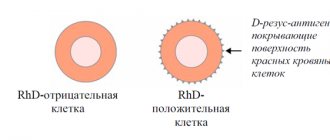How is amniocentesis done?
This invasive procedure is performed using a syringe connected to a long, hollow needle. It punctures the abdominal wall, uterus and amniotic membrane, after which a sample of amniotic fluid is “pulled” through it with a syringe or, conversely, a medicinal solution is injected.
The procedure is carried out in two ways:
- Free hand method.
The puncture is carried out under ultrasound control, with the help of which the area of needle insertion is specified. It is selected in such a way that there is no placenta in this place or its wall has a minimum thickness. This avoids possible complications and reduces the risk of damage to the fetus. - Using an adapter.
The difference between this method is the pairing of the needle with an ultrasound sensor, with the help of which the trajectory of its movement is first calculated depending on the insertion in a particular place. At the same time, the doctor performing the procedure has the opportunity to observe the needle itself and its trajectory, thereby choosing the most optimal route for its advancement. However, even in this case, the operation requires highly qualified and experienced surgeons.
The total duration of the procedure including preparation is approximately 5 minutes. Of these, 1 minute is spent on the puncture, and the remaining time is taken to collect amniotic fluid and remove the needle. For 2 hours after the operation, the patient rests and is under the supervision of a doctor to avoid possible complications. To reduce pain during the puncture, local anesthesia can be used. However, doctors recommend doing without it - the pain from an anesthetic injection is in no way inferior to that of the operation itself. In addition, the anesthetic may cause individual intolerance.
To find out more, you can consult with our specialists by filling out the form: Make an appointment
List of the most effective drugs for injection and their pharmacological properties
Most often, doctors use Clexane and Fraxiparine for pregnant women. The basis of these drugs is low molecular weight heparin, which does not cause harm during gestation. Both medications are available in the form of a filled disposable syringe and a hollow needle. Everything is packed in a blister. Each syringe contains a single dose. There is no need to dilute the composition in the future.
Analogues of these drugs are Heparin, Fragmin, Heparin sodium and Tsibor. All injections are given subcutaneously in the stomach. Fragmin and Heparin can be used for intravenous bolus administration.
The basis of Clexane is enoxaparin sodium. It has high anticoagulant activity. In addition, the active substance has anti-inflammatory properties.
Pregnant women are most often prescribed Fraxiparine, since it has a higher degree of purification and has fewer side effects. The drug consists of nadroparin. Compared to heparin, which is not divided into fractions, this substance has less impact on platelet function and primary hemostasis.
Fragmin also consists of low molecular weight heparin. It has almost no effect on blood clotting time and platelet adhesion, while working as an anticoagulant.
The pharmacological properties of Heparin and Cibor are no different from their more common analogues.
Preparing for amniocentesis
To increase the effectiveness of the study and reduce the risks of possible complications, the patient should carry out the following preparatory measures:
- Have a consultation with a doctor, where he will tell you in detail about the procedure, its possible complications, contraindications, etc.
- Take tests and undergo an ultrasound to identify hidden infectious or inflammatory diseases, the presence of neoplasms, the volume of amniotic fluid, to confirm or refute a multiple pregnancy. They also help determine the gestational age, condition and viability of the fetus.
- Approximately 4-5 days before amniocentesis, the patient should avoid taking acetylsalicylic acid or similar drugs, and 12-24 hours before, stop taking drugs that reduce blood clotting to reduce the risk of bleeding.
These measures must be performed in order to increase the safety of amniocentesis, reduce the risk of complications for the woman and her child, and increase the efficiency of diagnosis.
What to do after amniocentesis?
Since this procedure is invasive, there are a number of rules that a woman must follow to avoid possible complications:
- It is necessary to exclude or, as far as possible, reduce any physical activity, especially heavy lifting.
- Immediately after the procedure, ensure that you rest for several hours.
- Patients with a negative Rh factor who are carrying a child with a positive Rh factor must undergo a course of injections of anti-Rhesus immunoglobulin for 72 hours. This is necessary in order to exclude Rh conflict due to the entry of amniotic fluid containing the genetic material of the fetus outside the amniotic sac.
Sometimes, to eliminate discomfort after amniocentesis, patients are prescribed painkillers. Also, in order to exclude inflammatory processes, non-steroidal anti-inflammatory drugs can be prescribed.
When is amniocentesis performed?
This procedure can be performed at various stages of pregnancy, but not earlier than 10 weeks after conception. It is then that the formation of the main systems and organs of the fetus occurs, so amniocentesis will be effective as a diagnostic procedure. The optimal period for performing this operation is from 15 to 20 weeks. This is due to the fact that during this period the risk of damage to the fetus is significantly reduced, the volume of amniotic fluid increases, which makes it easier to take a sample for analysis.
The optimal period for amniocentesis is determined based on its goals:
- to identify genetic disorders of the fetus, the puncture is performed at 15 weeks;
- to check the formation of the respiratory system of the embryo, the optimal period is the 3rd trimester;
- to determine the condition of the fetus in case of Rh conflict, amniocentesis is performed in the last months of pregnancy.
If for some medical reason (often these are fetal pathologies incompatible with life) a woman is prescribed an abortion, then through amniocentesis, injectable abortifacient drugs are injected into the bladder to terminate the pregnancy.
When are abdominal injections indicated for pregnant women?
Clexane and Fraxiparine are used for abdominal injections in pregnant women. These are nicomolecular heparin preparations, which are relatively safe during gestation. There are strict indications for their use:
- deep vein thrombosis;
- prevention of thrombosis in diagnosed thrombophilia;
- treatment of myocardial infarction;
- forced long-term bed rest as a result of surgery, injury, serious condition due to acute diseases of the heart or respiratory system.
Thrombophilia is a disease of the blood coagulation system that increases the risk of blood clots. This may be a congenital pathology as a result of mutations of various genes or an acquired condition. A common condition in pregnant women is antiphospholipid syndrome, which increases the risk of microthrombosis. They often affect the vessels of the uterus, which leads to miscarriage.
When registering, a woman must undergo a coagulogram. The doctor pays attention to fibrinogen. If its indicators are normal, the analysis is repeated once every trimester. If deviations are detected - every week.
Can a pregnant woman get an injection in the stomach?
Clexane and Fraxiparine are drugs that are not used in the first trimester. They do not have a proven teratogenic effect on the fetus, but when tested on laboratory pregnant animals, some deviations in the development of the fetus were identified. It is unknown how the medicine will behave in pregnant women: further tests have not been carried out on women.
Therefore, heparins are not used in the first trimester - at the time of the formation and formation of the main organ systems. After the placenta has formed, the administration of drugs is relatively safe. They do not penetrate the placental barrier.
But there are certain contraindications for injections:
- threatened abortion;
- individual intolerance;
- with artificial valves in the heart;
- with a high risk of bleeding.
Prescribe with caution in the following conditions:
- peptic ulcer of the stomach and duodenum;
- high-grade hypertension;
- type 2 diabetes mellitus with severe vascular disorders;
- severe liver and kidney diseases;
- rehabilitation period after surgery.
There is no risk of prescribing anticoagulant injections into the stomach at the same time as other drugs that affect blood clotting.
Application of amniocentesis
Amniocentesis during pregnancy is used primarily as a diagnostic procedure to detect certain genetic disorders in the fetus - for example:
- Down syndrome
, characterized by abnormalities in mental development, defects of internal organs and abnormal appearance; - Patau syndrome
, which is characterized by external abnormalities, developmental disorders of the central nervous system and brain, incompatible with life (the newborn dies a few days later); - Edwards syndrome
, accompanied by disturbances in the structure of internal organs (most often the heart), mental retardation, early mortality (the average life expectancy of such children is several months); - Turner syndrome
, which manifests itself exclusively in girls in the form of malformations of internal organs, infertility, short stature (although people with such pathology do not have deviations in intellectual development and can lead a full life); - Klinefelter syndrome
, characteristic only of men and accompanied by elongation of the limbs, high waist, gynecomatia, delayed puberty, testicular atrophy, infertility.
In addition to identifying genetic abnormalities in the fetus, amniocentesis during pregnancy is used to monitor the overall development of the child’s organs and systems in women at risk.
Indications for amniocentesis are:
- The presence of genetic abnormalities in a pregnant woman or her relatives;
- A woman’s age exceeds the 35-year mark (after which the risk of the formation of an extra 21 chromosome pair in the ovaries increases);
- Results of an ultrasound examination - for example, identification of an enlarged gap between the neck bone and the skin of the fetus, characteristic of Down syndrome;
- The results of biochemical screening are an excess of the normal level of hCG or an abnormally low concentration of PAPP-A (a specific protein contained in the blood plasma).
Another area of use of this technique is artificial termination of pregnancy. In this case, using a puncture needle, solutions of drugs that kill the fetus and promote its rejection and expulsion from the uterus are introduced into the amniotic fluid.
Indications and contraindications for abdominal injections
Since childbirth is always accompanied by blood loss, even during pregnancy the body increases blood clotting. The amount of fibrinogen increases, and along with it the work of antithrombins is blocked. If the expectant mother has a pronounced tendency to form blood clots, then this poses a threat not only to her, but also to the life of the fetus.
Injections in the abdomen to thin the blood during pregnancy help stabilize the situation. They are used only as prescribed by the attending physician. Injections are given by the woman herself or by a medical professional.
Indications for prescribing the drug during pregnancy are the following patient diagnoses:
- thrombophilia;
- deep vein thrombosis and bleeding due to a decrease in platelet count;
- myocardial infarction;
- long-term bed rest for cardiovascular diseases, pathologies of the respiratory system, after surgery or complex trauma.
Pregnant women are prescribed injections when diagnosed with DIC syndrome. This disease carries a risk for the fetus: the child starves when the vessels of the uterus are damaged and, if the necessary measures are not taken in time, it subsequently ends in his death. A woman may also experience negative consequences, even fatal ones: severe blockage of blood vessels and hemorrhage in the brain.
In this regard, during pregnancy, all patients undergo a blood test during registration, which is called a coagulogram. It allows you to track fibrinogen parameters. Its norm: 2-4 g/l. If the indicators are too high, treatment is prescribed, and the analysis is repeated every 7 days. If fibrinogen is within normal limits, then a coagulogram must be taken once a trimester.
The first trimester of pregnancy is considered a contraindication to the use of heparin-based drugs. They do not have a positive effect on the blood flow of the embryo during this period, but in the course of studies conducted on pregnant animals, a negative effect of the substance on the formation of the fetus was discovered. No further trials were carried out on expectant mothers in the 1st trimester.
Since active formation of organs and all important systems takes place up to 12 weeks, and blood flow is carried out through the chorionic villi, injections are not prescribed. Subsequently, the placenta begins to function, through which the active substance does not penetrate and cannot harm the unborn child.
In addition to early pregnancy, there are a number of contraindications to the use of abdominal injections:
- risk of miscarriage;
- relapse of gastric ulcer;
- disturbances in the functioning of the pancreas;
- active form of tuberculosis;
- aneurysm;
- artificial heart valve;
- history of hemorrhagic or ischemic stroke;
- high risk of bleeding.
Individual intolerance to heparin by patients cannot be discounted. Injections are used with caution for high blood pressure, kidney or liver problems, type 2 diabetes and the postoperative period.
Contraindications to amniocentesis
This diagnostic procedure is excluded if the patient has:
- Elevated temperature;
- Acute stage of chronic diseases;
- Infectious diseases;
- Factors that threaten the life of the fetus (placental abruption, uterine contractions);
- Bloody discharge;
- Congenital or acquired disorders of the structure of the uterus;
- Infectious lesions of the abdominal cavity and its organs;
- Low blood clotting; v
- Benign neoplasms of the uterus (fibroids).
Complications during amniocentesis
Due to the invasive nature of this procedure, there are certain risks for the health of the child and the mother herself:
- Spontaneous termination of pregnancy (miscarriage) or premature birth;
- Violation of the integrity of the placenta or the tissues of the embryo itself with a puncture needle;
- Damage to the bladder, uterus or other pelvic organs;
- Inflammation of the amniotic sac, infection of the amniotic fluid with infectious agents;
- Placental abruption, bleeding, damage to the umbilical cord, etc.
Even if amniocentesis is performed correctly, the patient may experience discomfort and pain in the abdominal area, bleeding, release of a small amount of amniotic fluid, etc.
Although in a medical setting the occurrence of these complications is minimized, the likelihood of them still remains. Therefore, doctors use this procedure relatively rarely, and when using it, they first warn the patient about the possible consequences. Often, alternative methods to amniocentesis are used to identify congenital defects in the fetus - for example, genetic analysis of embryonic DNA isolated from the woman’s blood plasma. Although this method shows less accurate results, it does not pose any threat to the life and health of the child.
The decision to perform amniocentesis is made by the pregnant woman herself after consultation with a specialist.
At her request, this procedure can be canceled or replaced with a safer or more effective one. However, amniocentesis remains one of the most effective ways to detect congenital abnormalities in the fetus, and therefore continues to be actively used in gynecological practice. To find out more, you can consult with our specialists by filling out the form: Make an appointment
Why is the drug injected into the abdominal area?
Injections directly into the abdomen allow long-term courses to be prescribed to patients during pregnancy. In severe cases, they can last until childbirth. This is important for women who suffer from high blood viscosity and are still carrying a child.
Since it is difficult for pregnant women to visit the treatment room every day, they can inject the medicine into the abdominal area on their own.
All drugs based on low molecular weight hyparin are destroyed in the digestive tract, so they are used in the form of injections. When administered into the subcutaneous layer of the abdomen, the therapeutic effect during pregnancy is achieved as quickly as possible and lasts for quite a long time.









